How to properly process raspberries in the fall: a description of the most important stages
Sweet, juicy raspberries are one of the favorite treats for kids in summer. But in order for the berry harvest to please every season, the bushes need to be looked after. This care is required for raspberries not only in spring and summer, but also in autumn.
For information on how to properly process raspberries in the fall and protect them from pests, read on.
The content of the article
Why is it important to care for raspberries in the fall
Raspberry belongs to unpretentious plants... She grows well and bears fruit, even if she is not looked after at all.
However, over time, the bushes grow. In conditions of thickening, they do not have enough sunlight, it is difficult to circulate air inside the bushes, the plants start to hurt.
All this leads to the fact that berries become smaller and they grow small and not so sweet... Simple care measures in spring and autumn are a prerequisite for obtaining a stable harvest of vitamin berries.
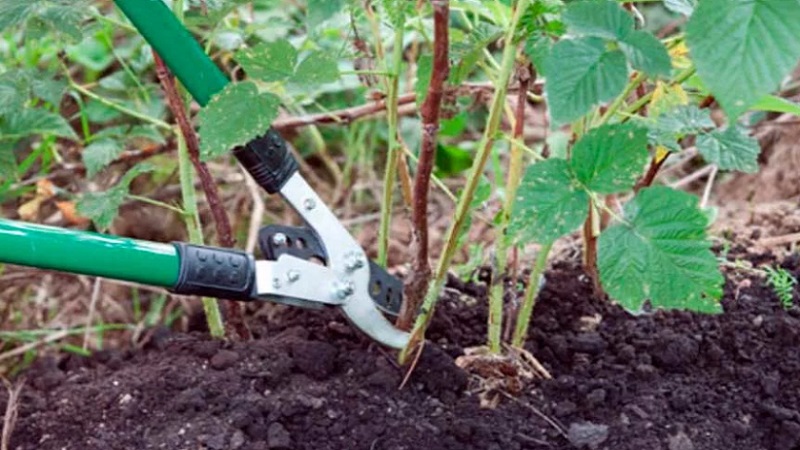
Stages of autumn care
Raspberry care in the fall includes:
- thinning and pruning;
- weeding;
- loosening the earth;
- feeding;
- watering and mulching plantings;
- shelter for the winter.
Processing time
The start time of autumn work depends on what type of shrub grows on the site.
Traditional varieties
These are unpretentious varieties that bear fruit on almost all types of soil and in any climate.... They yield a crop once a season.
Autumn activities for the care of such shrubs begin from the end of August.... At this time, the fruiting period is already over, and the plant begins to prepare for winter.
The growth of the stems stops, the wood changes the green color of the bark to brown and thickens to protect against cold weather. The shrub goes into a dormant stage, completing active processes. With the fall of the first snow, all metabolic processes stop.
Repaired varieties
The fruiting period in these varieties ends only with the onset of cold weather.
Need to know! Processing schemes for traditional and remontant raspberries are different. The remontant bears fruit twice a season, so the timing of its pruning is shifted to late autumn.
Pruning of remontant varieties begins in late autumn., about two weeks before the expected frost. By this time, the second wave of fruiting ends. Processing begins after the foliage has fallen, since in the fall the remontant raspberry takes away nutrients from it for the root system.
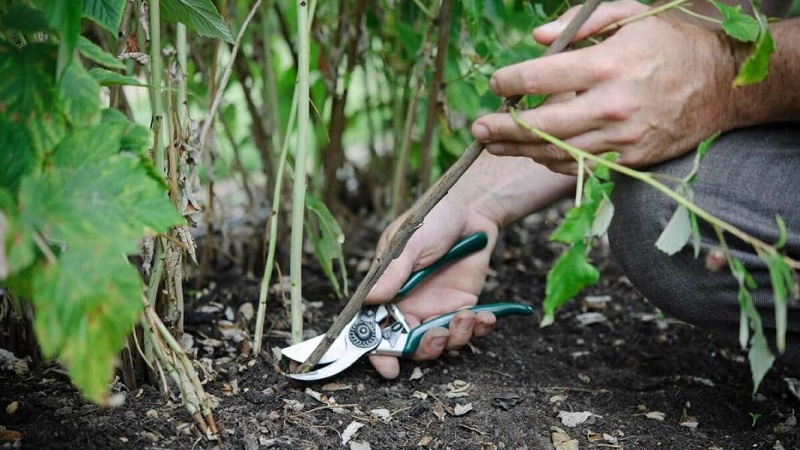
Cutting technology
The first thing to do is thin out the raspberry tree by removing all excess trunks and shoots.... Thus, you will provide good ventilation and illumination of plantings, reduce the risk of disease and pest damage.
Required tools
For work, you need clothes made of thick fabric, gloves to protect the skin from thorny stems and a sharp pruner... Remember to disinfect the tools before and after work. So you will protect the shrub from infection with diseases.
Schemes and instructions
Planting processing begins with the removal of all sick, broken, poorly developed and pest-affected shoots... The branches are cut at the very root, without leaving a stump. Then remove all two-year-old shoots.
Attention! The main purpose of the pruning procedure is to remove the old two-year-old shoots. They are distinguished from annuals by their brown, stiff trunk.
Of the annuals, only well-developed branches are left... Be sure to shorten the tops by 10 cm. This part does not bear fruit and slows down the preparation of the main stem for winter.
The bushes are thinned out so that no more than 8-10 stems remain per 1 m²... All cut raspberries are removed from the site and burned.
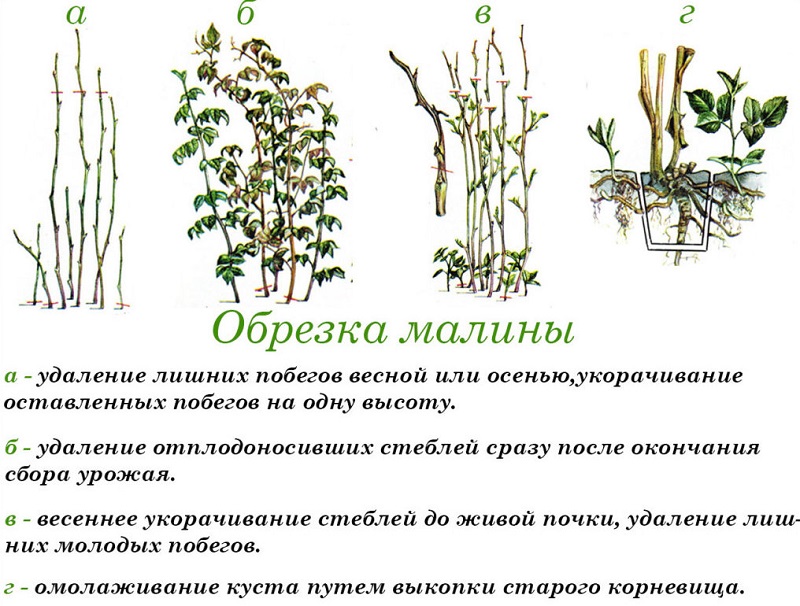
The nuances of pruning remontant raspberries
Repaired raspberries bear fruit both on two-year-old shoots and on annuals... Therefore, two-year-old trunks are not removed, but only the tops are pinched. In annual shoots of remontant raspberries, the tops are not shortened, since the berry harvest is laid there.
After harvesting the first crop, remove the sprouted shoots to get the second one as soon as possible.
In regions with a short summer, the second raspberry crop does not have time to ripen... In such areas, remontant raspberries are grown as an annual plant. This means that the aboveground part is cut off completely in the fall. And next season, new annual shoots will bear fruit.
Processing after trimming
After removing the excess stems, the raspberries are carefully weeded and loosened the soil... Weeds must be removed without fail, since they use the nutrients and soil moisture necessary for cultivated plants.
Overgrown weeds shade plantings and increase moisture in the root zoneby promoting the development of rot and other raspberry diseases. On them, foci of infections remain and pests overwinter.
After weeding, the soil is loosened... If raspberries are planted in two or more rows, a ditch is made between them for autumn watering and fertilization.
Features of care depending on the region
In a number of cases, it is advisable to prune the fruit-bearing shoots not in autumn, but in early spring.... It depends on the region of cultivation.
Spring pruning is more suitable for regions with mild winters... Indeed, in warm climates, raspberries continue to grow and accumulate nutrients even after the fruiting period.
And in areas with severe and little snowy winters, unremoved sprouted shoots contribute to better snow retention and successful wintering.
Additional care measures
Besides trimming, weeding and loosening, planting raspberries need feeding and protection from diseases and pests.
Fertilization
For successful wintering and full growth in the spring, fertilizers are applied to the soil... Plants need nitrogen to develop the root system in spring. However, if you have already applied nitrogen fertilizers in the summer, you do not need to do this additionally in the fall.

As the main phosphorus fertilizer in the fall, apply superforsfat, embedding it in the soil. The shrub also needs potassium for successful wintering, therefore, the soil is additionally fertilized with potassium magnesium or potassium monophosphate.
When calculating the required amount of dressings, follow the instructions. Remember that too much nutrient is just as bad for plants as not enough.
Alternatively use complex phosphorus-potassium fertilizers for shrubs.
Protection against diseases and pests
Another important stage of autumn work with raspberries is the treatment of shrubs for protection from pests and diseases. Insect larvae and causative agents of fungal diseases hibernate in the bark. In spring, they wake up and harm young shoots.
They start processing after pruning, but before mulching.... The raspberry tree is cleaned of foliage, cut branches, and residual mulch.
How to treat raspberries from pests? To protect against insects, the bushes are sprayed with special agents. The names of the drugs most effective against hibernating pests:
- "Fufanon" - insectoacaricide to protect against a complex of pests;
- "Intavir" is an enteric-contact insecticide against various types of pests.
To prevent the development of diseases, plantings are sprayed Bordeaux liquid and copper sulfate solution.
Interesting on the site:
Rules for feeding cherries in autumn
Watering and mulching the soil
This is the final stage of autumn work... Raspberries are moisture-loving shrubs, so if the soil is dry, it is watered abundantly before wintering.
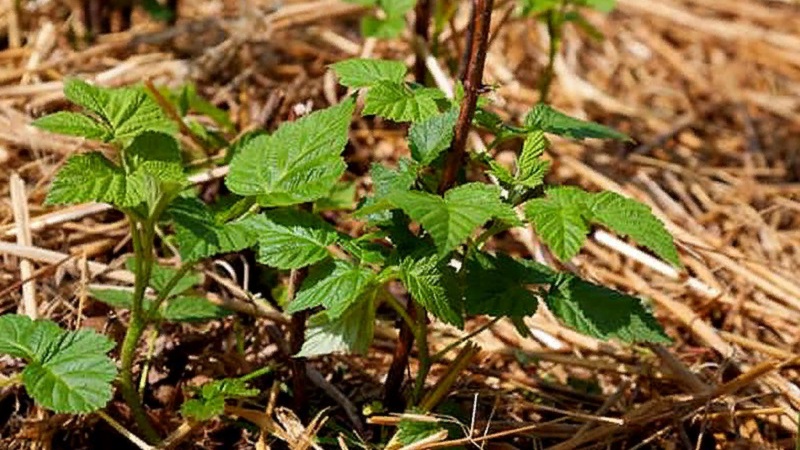
When the water is absorbed, the soil surface is mulched... This will protect the root system from hypothermia, retain moisture in the soil and slow down the growth of weeds.
Important!The root system of raspberries is afraid of frost, as it is located only 20-30 cm from the surface of the earth.
How to mulch raspberries in autumn and how to do it correctly? For autumn mulching use peat, straw, sawdust or rotten foliage... The selected material is poured around the stems in a layer of 8-10 cm.
Preparing for the cold
Caring for raspberries in autumn ends with bending the branches to the ground... After pruning, the stems are tied with ropes, a load is tied and carefully tilted. Bending down is best done before the onset of frost, while the raspberry stems are still flexible.
When grown in the southern regions and central Russia, it is not necessary to cover raspberries... It is enough to cover the soil well to protect the roots.
And in the Urals, Siberia and especially in the northern regions, the shrub needs in additional insulation.
One option is to wrap the bushes with spunbond or other suitable material.... In this case, the free space between the branches is filled with straw. The shoots bent to the ground are also covered with foliage or spruce branches.
Need to know! An overly wrapped shrub will begin to rot during thaws and winter rains and will die as a result. Therefore, when choosing material for shelter, focus on the climate of your region.
The simplest and most effective way of warming is to cover the bushes with snow.... The snow cover should cover them entirely.
The condition of the planting plays an important role for successful wintering. Cold resistance is lower in bushes overfed with nitrogen, which have not completed their growing season in the fall, in thickened, diseased and growing in the shade bushes.
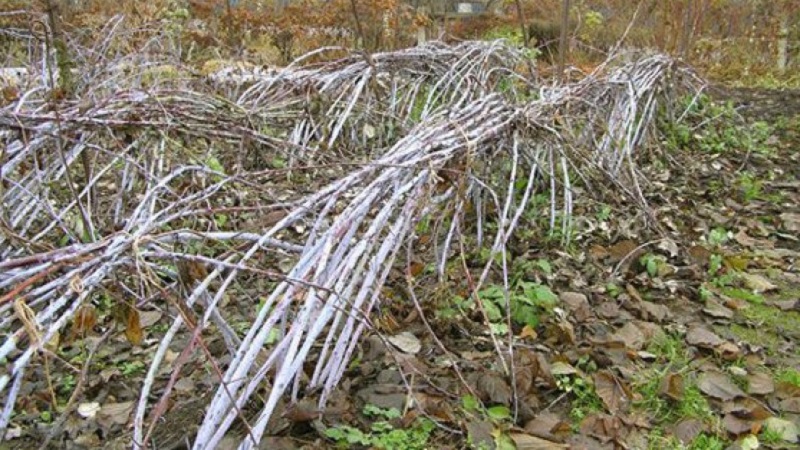
Rejuvenation of old bushes
Raspberry plantings successfully grow and bear fruit in the same place for many years... If you got a plot with an old raspberry tree, it is not necessary to uproot it and lay a new one.
Rejuvenation of old plantings carried out in the fall gives a good result... The plantings are examined and the oldest, non-fruiting bushes are marked. Around each such bush, they dig up the earth with a shovel, cutting off the roots, and remove it.
The resulting voids are filled with compost or humus and compacted... From the root shoots remaining in the ground, new shoots will appear in this place in the spring. After the procedure, the raspberry plant is well watered.
Removal of old roots is carried out in stages over 2-3 years, gradually completely renewing the landing.
Experienced gardening tips
Tips and tricks from experienced gardeners will help care for raspberries correctly and get a stable harvest every season:
- After completing all the autumn work in the raspberry tree, cut off the roots that are spreading beyond its borders. To do this, use a bayonet shovel to walk around the bushes at a distance of 30-40 cm. Perform the procedure once a year in the fall to avoid the spread of raspberries throughout the area.
- When laying a new raspberry tree, dig into the ground the remnants of slate or metal along the perimeter of the garden to a depth of 40-50 cm. This will limit the growth of roots.
- Cut the stems flush with the ground. Pathogens and larvae of pests winter on protruding stumps.
- When thinning bushes in the fall, also remove all small growth. These stems will not have time to get stronger before the arrival of cold weather.
- When pruning, ruthlessly remove old shoots.The shrub has a two-year life cycle; after the second year, the shoots stop growing and dry out.
Conclusion
Raspberries, like any garden culture, need care. For the growth and formation of fruits, it needs sunlight, space, moisture and nutrients. Dense planting, neglect of fertilizing and watering lead to crushing of berries and a decrease in yield indicators.
Spending a little time pruning, weeding, and fertilizing in the fall will reward you with lots of healthy and flavorful berries next summer.